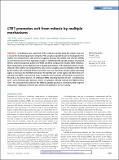LTE1 promotes exit from mitosis by multiple mechanisms
Author(s)
Joyce, K.; Whalen, J.; Seshan, A.; Falk, Jill E.; Campbell, Ian Winsten; Amon, Angelika B.; ... Show more Show less
DownloadFalk-2016-LTE1 promotes exit from mitosis by m.pdf (3.872Mb)
PUBLISHER_CC
Publisher with Creative Commons License
Creative Commons Attribution
Terms of use
Metadata
Show full item recordAbstract
In budding yeast, alignment of the anaphase spindle along the mother–bud axis is crucial for maintaining genome integrity. If the anaphase spindle becomes misaligned in the mother cell compartment, cells arrest in anaphase because the mitotic exit network (MEN), an essential Ras-like GTPase signaling cascade, is inhibited by the spindle position checkpoint (SPoC). Distinct localization patterns of MEN and SPoC components mediate MEN inhibition. Most components of the MEN localize to spindle pole bodies. If the spindle becomes mispositioned in the mother cell compartment, cells arrest in anaphase due to inhibition of the MEN by the mother cell–restricted SPoC kinase Kin4. Here we show that a bud-localized activating signal is necessary for full MEN activation. We identify Lte1 as this signal and show that Lte1 activates the MEN in at least two ways. It inhibits small amounts of Kin4 that are present in the bud via its central domain. An additional MEN-activating function of Lte1 is mediated by its N- and C-terminal GEF domains, which, we propose, directly activate the MEN GTPase Tem1. We conclude that control of the MEN by spindle position is exerted by both negative and positive regulatory elements that control the pathway’s GTPase activity.
Date issued
2016-10Department
Koch Institute for Integrative Cancer Research at MITJournal
Molecular Biology of the Cell
Publisher
American Society for Cell Biology
Citation
Falk, J. E. et al. “LTE1 Promotes Exit from Mitosis by Multiple Mechanisms.” Molecular Biology of the Cell 27.25 (2016): 3991–4001.
Version: Final published version
ISSN
1059-1524